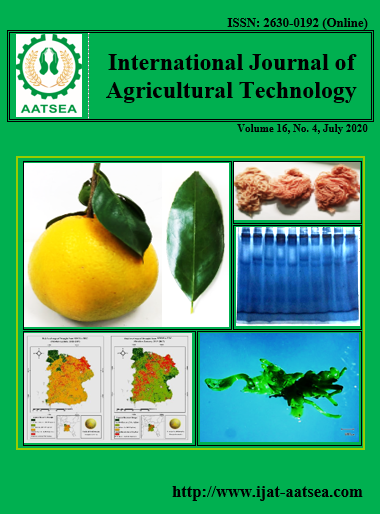Impact of coconut sugar syrup on quality of acidophilus milk during cold storage
Main Article Content
Abstract
The influence of coconut sugar syrup on physico-chemical, microbiological and sensory properties of acidophilus milk during storage at 4°C for 8 days was investigated. Four formulations of acidophilus milk were tested with adding different coconut sugar syrup levels. Result showed that addition of coconut sugar syrup had significant effect on TSS of acidophilus milk formulations. However, there were no significant differences among formulations for pH, acidity and reducing sugar and DPPH radical scavenging activities during storage. Counts of Lactobacillus acidophilus TISTR 2365 were averaged 7.0 log cfu/ml throughout storage for all acidophilus milk formulations. Escherichia coli counts were less than 3 MPN/g and the counts of yeast and mold were less than 100 cfu/ml in all acidophilus milk formulations throughout storage period. The incorporation of coconut sugar syrup improved significantly sensory attributes. The surviaval of probiotic bacteria and sensory characteritics of acidophilus milks containg coconut sugar syrup were satisfactory for probiotic foods throughout cold storage.
Article Details

This work is licensed under a Creative Commons Attribution-NonCommercial-NoDerivatives 4.0 International License.
References
Amiri, Z. R., Khandelwal, P. and Aruna, B. R. (2010). Development of acidophilus milk via selected probiotics and prebiotics using artificial neural network. Advances in Bioscience and Biotechnology, 1:224-231.
Chramostova, J., Mosnova, R., Lisova, I., Pesek, E., Drbohlav, J. and Nemeckova, I. (2014). Influence of cultivation conditions on the growth of Lactobacillus acidophilus, Bifidobacterium sp., and Streptococcus thermophiles, and on the production of organic acids in fermented milks. Czech Journal of Food Science, 32:422-429.
Demirci, T., Aktas, K., Sozeri, D., Ozturk, H. I. and Akin, N. (2017). Rice bran improve probiotic viability in yoghurt and provide added antioxidantive benefits. Journal of Functional Foods, 36:396-403.
Gjorgievski, N., Tomovska, J., Dimitrovska, G., Makarijoski, B. and Shariati, M. A. (2014). Determination of the antioxidant activity in yogurt. Journal of Hygienic Engineering and Design UDC637, 272:88-92.
Junaid, M., Javed, I., Abdullah, M., Gulzar, M., Younas, U., Nasir, J. and Ahmad, N. (2013). Development and quality assessment of flavored probiotic acidophilus milk. Journal of Animal and Plant Science, 23:1342-1346.
Kun, L. Y. (2013). Microbial biotechnology principles and applications. Singapore, World Scientific Publishing.
Low, R. H. P., Baba, A. S. and Aboulfazli, F. (2015). Effects of different levels of refined cane sugar and unrefined coconut palm sugar on the survivability of Lactobacillus acidophilus in probiotic ice cream and its sensory and antioxidant properties. Food Science and Technology Research, 21:857-862.
Machada, T. A. D. G., Oliveira, M. E. G. D., Campos, M. I. F., Assis, P. O. A. D., Souza, E. J. D., Madruga, S., Pacheco, M. T. B., Pintada, M. M. E. and Queiroga, R. D. R. D. E. (2017). Impact of honey on quality characteristics of goat yogurt containing probiotic Lactobacillus acidophilus. LWT-Food Science and Technology, 80:221-229.
Miller. G. L. (1959). Use of Dinitrosalicylic acid reagent for determination of reducing sugar. Analytical Chemistry, 31:426-428.
Ministry of Public Health (2013). Notification of the Ministry of Public Health (No. 353) B.E. 2556 RE: Fermented milk. Thailand. Retrieved from http://extwprlegs1.fao.org/docs/pdf/tha159846.pdf.
Najgebayer-Lejko, D. (2014). Effect of green tea supplementation on the microbiological, antioxidant, and sensory properties of probiotics milks. Dairy Science and Technology, 94:327-339.
Nematollahi, A., Sohrabvandi, S., Mortazavian, A. M. and Jazaeri, S. (2016). Viability of probioctic bacteria and some chemical and sensory characteristics in cornelian cherry juice during cold storage. Electronic Journal of Biotechnology, 21:49-53.
Oliveria, R. P. D. S., Florence, A. C. R., Perego, P., Oliveira, M. N. D. and Converti, A. (2011). Use of lactulose as prebiotic and its influence on the growth, acidification profile and viable counts of different probiotics in fermented skim milk. International Journal of Food Microbiology, 145:22-27.
Panesar, P. S. and Marwaha, S. S. (2014). Biotechnology in Agriculture and Food Processing Opportunities and Challenges. New York, Taylor and Francis Group.
Philippine Coconut Authority (2015). Coconut sap sugar. Food Product Development Division (FPDD) Guide No.5-Series of 2015. Retrieved from http://www.pca.da.gov.ph/coconutrde/images/coconut%20sugar%20final.pdf.
Purnomo, H. (2007). Volatile components of coconut fresh sap, sap syrup and coconut sugar. ASEAN Food Journal, 14:45-49.
Ranadheera, C. S., Evans, C. A, Adams, M. C. and Baines, S. K. (2012). Probiotic viability and physic-chemical and sensory properties of plain and stirred fruit yogurts made from goat’s milk. Food Chemistry, 135:1411-1418.
Ranadheera, C. S., Evans C. A., Adams, M. and Baines, S. K. (2016). Co-culturing of probiotics influences the microbial and physio-chemical properties but not sensory quality of fermented dairy drink made from goats’ milk. Small Ruminant Research, 136:104-108.
Ray, R. C. and Montet, D. (2015). Microorganisms and Fermentation of Traditional Foods. New York, Taylor and Francis Group.
Sah, B. N. P., Vasiljevic, T., McKechnie, S. and Donkor, O. N. (2016). Physicochemical, textural and rheological properties of probiotic yogurt fortified with fibre-rich pineapple peel powder during refrigerated storage. LWT-Food Science and Technology, 65:978-986.
Srikaeo, K. and Thongta, R. (2015). Effects of sugarcane, palm sugar, coconut sugar and sorbitol on starch digestibility and physicochemical properties of wheat based foods. International Food Research Journal, 22:923-929.
Tripathi, M. K. and Giri, S. K. (2014). Probiotic functional foods: survival of probiotics during processing and storage. Journal of Functional Foods, 9:225-241.
Yildiz, F. (2010). Development and Manufacture of Yogurt and Other Functional Dairy Products. New York, Taylor and Francis Group.
Yousef, A. E. and Carlstrom, C. (2003). Food Microbiology: A Laboratory Manual. New Jersey, John Wiley and Sons.


